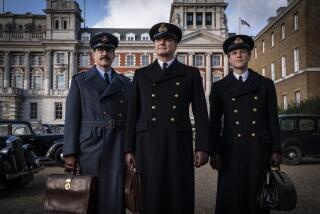Bill Jewell, 90; British Officer Used a Corpse to Deceive Nazis in WWII
- Share via
Bill Jewell, the British submarine skipper who had a vital role in one of the more macabre and celebrated clandestine operations of World War II -- using a corpse planted with fake documents to fool Nazi intelligence -- has died. He was 90.
Jewell, who had been paralyzed from the neck down since a fall in 1998, died Aug. 18 in a nursing home for disabled veterans in Richmond Upon Thames, Surrey, England.
Operation Mincemeat, as the wartime plan was known, was shrouded in such secrecy that not even Jewell’s after-the-fact memoir noted the caper. Only later did books, articles and a 1956 film, “The Man Who Never Was,” detail aspects of the story.
The deceit was intended to distract from the Allies’ planned 1943 invasion of Sicily and sweep into Italy -- the quickest way for them to reach Nazi-held Europe from North Africa. British intelligence formed a ruse: to plant on the southwest Spanish coast the body of a sham Royal Marines officer carrying “invasion” plans for Sardinia and southern Greece.
For most of his voyage, Jewell was the only one aboard his submarine, the Seraph, to know about the feint. He was mum about the contents of a metal container in cold storage: an unidentified corpse from an English mortuary. Renamed Maj. William Martin, the body was chained to a briefcase containing false invasion plans.
Naval intelligence also decided to add to Martin’s portfolio signed letters from ranking officials, two theater stubs and a dramatic love letter from his “fiancee.”
In the pitch darkness at sea, as the Seraph hovered in the Gulf of Cadiz a mile off the Spanish coastline, Jewell ordered the metal container taken to the deck. It was 4:30 a.m. on April 30, 1943.
He told the crew below he intended to launch a meteorological device. On deck, with only a few trusted officers watching, he gave a short burial service, reciting Psalm 39. He heaved the body into the water with a life vest and an upside-down life raft.
Back in London, death notices appeared for Martin, who was said to have died in a plane crash.
As expected, the body made its way to shore -- it was netted by a fisherman -- and was buried in fascist-ruled neutral Spain. Although Spanish authorities returned the briefcase to the British, they had given copies of its contents to the Germans.
The German high command took the bait and began arming for an invasion in Corsica and Sardinia, islands west of mainland Italy.
The fortification of the wrong landing points was said to have been a costly error for German defenses. Hitler also sent Field Marshal Erwin Rommel to Greece and pulled two vital armored divisions from the Russian front.
“Operation Mincemeat had been an unqualified success,” World War II magazine reported in 1995.
Norman Limbury Auchinleck Jewell was born Oct. 24, 1913, in the Seychelles, where his father was a colonial officer. He was educated in England and joined the Royal Navy in 1936, volunteering for the submarine service.
According to World War II magazine, Operation Mincemeat almost was scuttled when British pilots initially mistook the surfaced Seraph for a Nazi vessel and strafed it with fire.
Among Jewell’s other missions was to bring French Gen. Henri Honore Giraud, in Vichy France hiding from the Germans, to Gibraltar. There, it was hoped, he would help rally French forces to the Allied cause in North Africa.
There was one problem: Giraud’s intense dislike for the British, enough so that he would not board a British vessel. To lure Giraud, Jewell’s HMS Seraph set sail as the USS Seraph, complete with an American flag and a crew that pretended to speak like Yanks upon meeting the French warrior.
Jewell’s decorations included the U.S. Legion of Merit, as well as several British and French awards for gallantry.
After retiring from the Navy as an admiral in 1963, Jewell worked for a brewing company in Birmingham, England.
His wife, Rosemary Galloway Jewell, whom he married in 1944, died in 1996. Survivors include two sons and a daughter.
More to Read
Sign up for Essential California
The most important California stories and recommendations in your inbox every morning.
You may occasionally receive promotional content from the Los Angeles Times.












